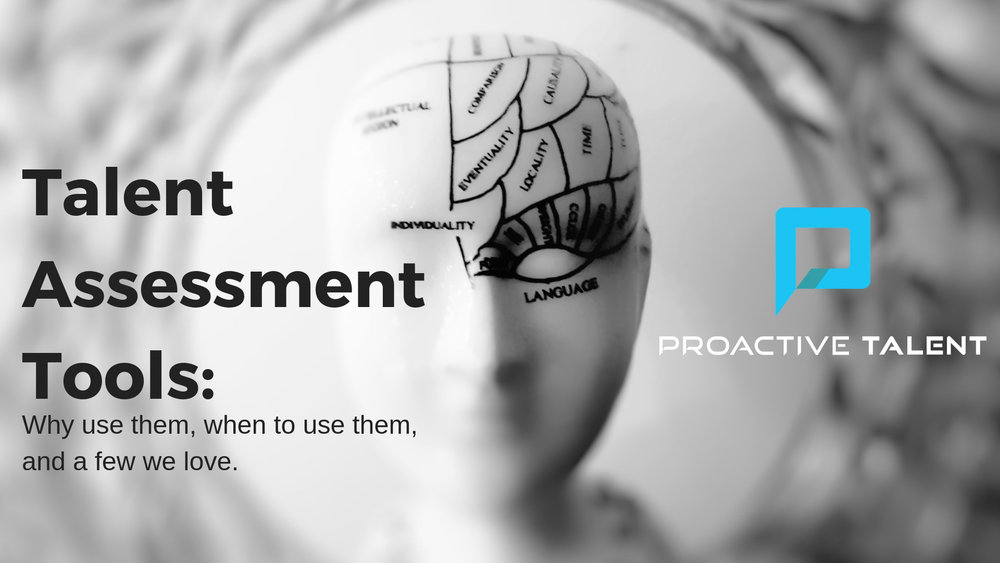
Since the dawn of civilization, when the first givers of work had more than one doer of work to choose from, measuring capabilities, skills, or fit for a job has been a part of the selection process. If you don’t believe me, just google “Han Dynasty employee testing”. And while the way we assess someone’s potential for success in a job has greatly changed since 1000 BC, our need for tools to help guide our people picking process has remained.
A century ago, in a job market made up of mostly laborers, brute strength or stamina were likely the tests of choice. Today, we have algorithm-driven technology that seamlessly inserts itself into our hiring processes called “talent assessments.” These assessments help employers decipher which candidates are more likely to be successful in a role. Same idea, new packaging. With the added bonus that the information from these assessments doesn’t stop being useful once a candidate has accepted an offer. Results of the talent assessment can also help guide future development and advancement plans for the new hire.
In today’s workforce, companies are faced with a generation of people deeply committed to the work they do rather than loyalty to any one employer. Previous generations were less motivated (or able) to change jobs with the frequency we see today. The result? Those turnover costs quickly multiply as workers are more willing to go somewhere else to simply be happier or more fulfilled.
However, deciding which talent assessment tools to use, can seem like a daunting task given the sheer number and variety of products on the market today. Building some kind of tool in-house is always an option, if you have a team of data scientists and technical experts available to dedicate time to the project and maintain it once launched. Let’s assume you choose to purchase this product. You need to first decide what you want to assess: job fit, culture fit, a little bit of both? To help you get started in your exploration of options, let’s discuss a few of these talent evaluation tools:
1. The Predictive Index allows you to easily walk through the process of understanding what you really need from a candidate in a specific job, as well as being able to assess both cognitive ability and behavioral fit. Each assessment takes less than 15 minutes to complete, so it is very user-friendly. The candidate assessment tool’s validity has been thoroughly tested and meets the standards set by the APA, SIOP, and ITC. Clients report improvements to hiring processes and improved engagement/productivity of employees. The tool also integrates with most ATS platforms.
While an easy tool for candidates to engage with, there is a learning curve for those reviewing results. HR & Hiring Managers alike report a slow ramp up for understanding results and effectively applying them to hiring decisions. If you choose to go this route, you will want to ensure you have a solid training plan in place to better equip your team. There is a lot of valuable information that can come from recruiting and hiring assessment tools like this, but it can be lost if your users don’t know what to do with it.
2. Wonderlic is another favorite in the assessment space due to its ease of use. There is a numeric rollup score (on a 1-100 scale) based on the cognitive, motivation, and personality scores. It’s a three in one setup, making it possible for HR and Hiring Managers to easily interpret the results and make a hiring decision. Fun fact: it’s the tool of choice by the NFL for its athlete evaluations. This tool also integrates with a long list of ATS platforms.
While clients give the tool high marks both for ease of use and results, we found a lack of stats available about the assessment’s validity or effectiveness. Likely an attempt to keep information easily digestible for the everyday consumer, if you consider this tool, ask for the data to back up the high scores from clients before making any final decisions.
3. 16 Personalities is not a pre-employment talent assessment (and is not advised nor approved to be used as one). It’s a post hire talent assessment tool, and it’s free! While we are fans of a good pre-hire assessment tool, we are really just fans of talent assessing at any point because organizations owe it to their teams to understand who they are and what they are capable of.
This is one of those job candidate assessment tools that is easy (and fun) to use and also happens to be highly reliable. It’s designed based on the Big Five Personality Types and for those who have done Myers-Briggs, will feel familiar with its use of acronyms for the different categories of results. Making it that much more user-friendly for your everyday person, it connects the personality types to concrete examples of real people and doesn’t stop with the workplace - insights to personal relationships are shared as well.
Whether you build it yourself or buy one, the cost of most talent assessment tools will likely be initially hard for some leaders to swallow. In these moments, it’s important to remember - good hires are easier to retain. And research shows that using talent assessments increases the likelihood of a good hire. Instead of paying for the loss of employees in turnover costs, leaders should be investing in the recruitment of talent that will be more productive, more engaged, and more inclined to stay.
For more information about candidate and talent assessment tools and how to use them to revolutionize your recruiting strategy, please check out our Recruiting Optimization service or give us a shout!


